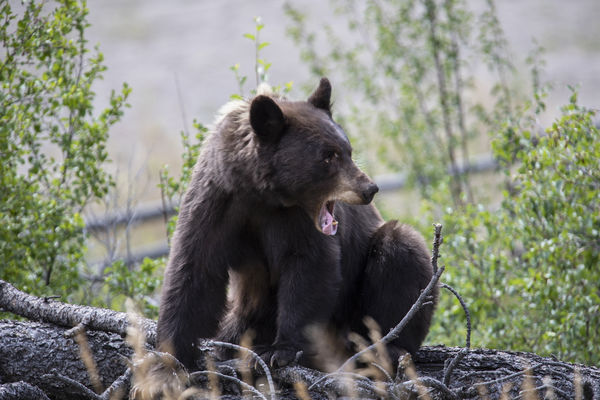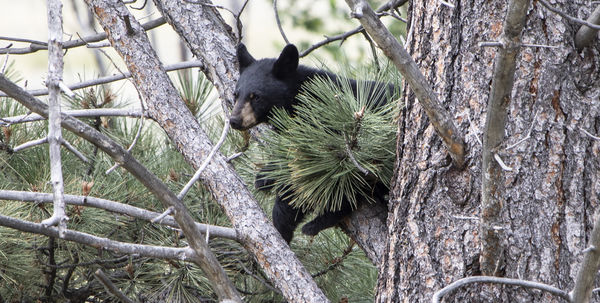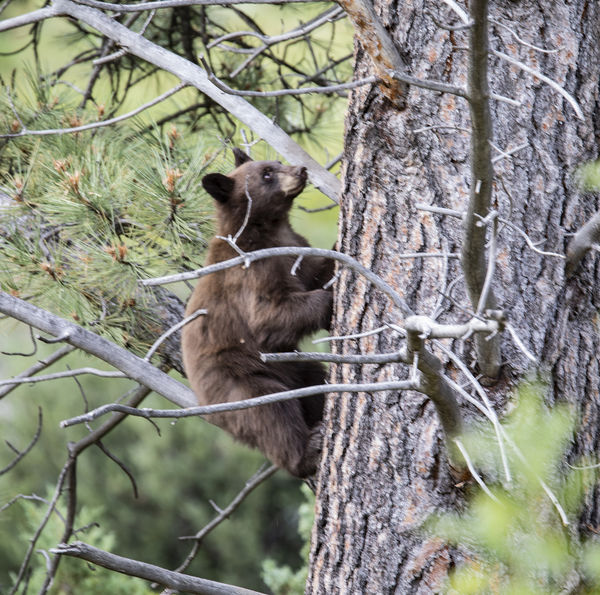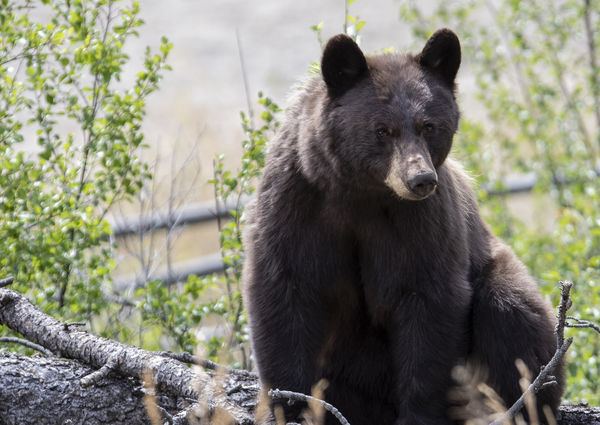Posts for: dkguill
Aug 27, 2019 14:03:13 #
E.L.. Shapiro wrote:
I love theses images! Any improvement woud just b... (show quote)
Absolutely do post your edit. After going through a number of my bear shots, I found that there were some that were soft because I couldn't get comfortable turning sidewise and hand-holding in a Mustang bucket seat. The cinnamon cub is just plain soft because I was moving and I only got a couple of shots, all of which turned out soft..."buck fever". I may post a couple more of momma bear later. She became more relaxed for a short while and there are some shots of her scratching and with tongue expressions. I look forward to your edit and suggestions.

Also,
Aug 27, 2019 12:24:57 #
I don't normally post my photos here, but I have been learning from the forum for a few years. My money shots are usually in my studio shooting commercial product photography. I just returned from about a week visiting my home turf in Montana. Fly fishing is my favorite reason to go back home these days since there aren't many relatives or friends left to visit. This trip resulted in a very disappointing fly fishing experience. Water was running pretty low this late in the year and my go to stream was suffering from an earlier blowout of an old mine that polluted the water causing warnings about not eating the fish for awhile. The bottom line is fishing was not good. I decided to wander a little farther afield in the hopes of finding some fishing excitement. During one of those excursions I found myself on a small gravel road near a creek that had some promise for trout. My son was driving and he suddenly came to a stop and asked if "that was a bear". I looked and confirmed that he had spotted a bear in tall grass at about 30 yards adjacent to the road. I rolled down my window and began shooting with my Canon 28-300 L lens. I took a few shots and then mounted my Tamron 150-600mm lens on the 5DMK4 and continued shooting. I was surprised that the bear didn't beat a path away from us, but she rather just held her ground and gave us a serious look. My son then spotted the reason for her focus on us. She had two cubs high in a large tree about 10 yards away from her. The position of the cubs and momma was lateral to us and the gravel road. I told my son to keep an eye on momma while I shot a few frames of the cubs and then her. I also suggested that we keep the motor running because momma was quite capable of covering the 30 yards between her and us rather quickly if she objected to our being there. Shooting hand-held in RAW, I was able to get a number of shots before she summoned the kids to come down and she hustled them off into the woods. I'm quite aware of some failings in my technique, however, I thought I would share what I thought was a rare opportunity to capture a mother bear and cubs in a wild setting from a short distance. Suggestions for what I could have done to improve the results are welcome, but I am pleased with the results of the experience. I admit to a bit of what we used to call buck fever and, in hindsight, I would have done some things differently. I hope you find these enjoyable.
Jul 5, 2019 11:30:12 #
stanikon wrote:
Please note the category in which it was originally posted. Please especially note the part that says "non-photography."
Point taken. I missed that reference. Thanks.
Jul 5, 2019 11:23:58 #
Kmgw9v wrote:
It still does, with an occasional bump in the road.
No problem.
No problem.
I'll give you the bump. The rest is indeed still quite useful. The bump imo is just unnecessary and distracting.
Jul 5, 2019 11:19:29 #
I thought this was a photography forum, but apparently not. That's a shame. It used to provide good information to photographers.
Apr 2, 2019 18:33:38 #
These are marvelous shots. Congratulations on capturing the emotion of the scene. Technically they are quite good, but emotionally they are gripping.
Jan 3, 2019 12:39:55 #
swartfort wrote:
No worries. FYI. These were shot jpg. br br As ... (show quote)
That's what I wanted to know. I appreciate your reply.
Jan 3, 2019 11:37:47 #
I like your selection of images, however, I hope you don't mind my asking a question about what post adjustments you may have made. In particular I'm referring to numbers 4,5, and 7. On my monitor it appears that there was a lot of sharpening applied so that the long, thin feathers around the neck and breast appears to be overly sharp. Also, I wonder about the area of the neck, as in #4, where the neck area appears to be lacking in feather detail so that it looks like retouching may have caused a blurring of detail in those areas. I see the same things to some extent in the other two images as well. Since the images have been reduced to 72ppi, it is perhaps more difficult to see fine detail. For my tastes, I have had to be careful not to overdo sharpening that I have a tendency to apply in an effort to emphasize crispness or focus. I don't mind being told that I'm wrong, but I would appreciate knowing what adjustments you may have made. Thanks...
Dec 23, 2018 09:44:40 #
mdpathjp wrote:
Taken right after a rainstorm.
Brings back fond memories of the first time I saw the Palouse as a freshman at Washington State University in 1961. Interesting history accompanies that vista. In those days, the hills were too steep for farmers to use conventional tractors so they used teams of horses and an occasional Caterpillar/crawler. Steptoe Butte is one of the landmarks in the area.
Thanks for posting a beautiful remembrance.
Dec 11, 2018 20:23:06 #
ORpilot wrote:
I have a set of Novatron 1600w, I used it to teach studio photography at the University of Alaska. It is in "like new" shape. It has 3 flash heads, and 3 umbrellas. Each head has a modeling light and is adjustable in power output. The main power unit is also adjustable in power output. I also have the snoot and a flash meter for it. These sell for over $1400 new. I am asking $600.
This looks like it would be a good buy to address the problem.
Dec 10, 2018 09:38:12 #
will47 wrote:
I do not have studio lights but have been thinking about getting started. Any thoughts about these?
https://www.bhphotovideo.com/c/product/1323079-REG/savage_led60k_r_savage_500w_led_studio.html/?ap=y&gclid=Cj0KCQiAurjgBRCqARIsAD09sg_Ab5-xMRGb8DAAo8jN2tOVPeqXR4JZ00KMfxesNZQgOZH-zbBmN5kaAtgXEALw_wcB
https://www.bhphotovideo.com/c/product/1323079-REG/savage_led60k_r_savage_500w_led_studio.html/?ap=y&gclid=Cj0KCQiAurjgBRCqARIsAD09sg_Ab5-xMRGb8DAAo8jN2tOVPeqXR4JZ00KMfxesNZQgOZH-zbBmN5kaAtgXEALw_wcB
Those will probably work to for limited applications in a small area, however, they will produce little in terms of light intensity. You should define exactly what kinds of photos you wish to take and in what kind of space before buying what might be totally inadequate for your purposes. Personally I prefer strobes to constant lighting. There are some mono lights that do a good job for a little more money. I'd suggest you save your money until you can afford some more substantial light units. In the meantime explore mastering the use of ambient light. I have used Alien Bees strobes for years and like them a lot. Look at this link https://www.bhphotovideo.com/c/product/1347245-REG/interfit_hb320_honey_badger_320_ws.html and other options on this site as a thought starter. A couple of 320Ws flash heads are very useful for a broad range of applications. Three are even better.
Oct 24, 2018 09:27:12 #
1826fairhaven wrote:
I am looking for advice as to which program is best for me as I am looking for something that is not overly complicated. I have been looking at Lightroom but am unsure if this is the way to go!
IMO, if you are serious about shooting in RAW and doing your own post work, the logical choice is Photoshop CC. You will get tons of advice to go directly to LR, however, I'll never understand why. You can't do everything in LR that you can do in Photoshop CC/bridge/Adobe RAW, all of which are available with your subscription to PSCC, but you can do everything you want and need to do in Photoshop. For me, the question early on was why add LR? In the case of Photoshop, you do have a rather steep learning curve. Likewise, there is a considerable learning curve for LR. LR was introduced as a cataloging application that would help you find your photos. IMO it has never come close to doing that job. Adobe had an investment in it and so they seem to have added some editing features to sell it, but they never fixed the issues with the original goal of quick and easy cataloging of image files. Again, IMO, Bridge serves the purpose of previewing and locating image files without complicated problems. I can store images on multiple hard drives and other storage devices and I can ask Bridge to locate and preview them. I suggest you develop a logical system of folders and sub-folders and then open the images, either JPGs or RAW files in ACR (Adobe Camera Raw) for basic post editing. Opening from ACR into PS is as simple as clicking one button. If no further adjustments are required you can immediately save to your appointed folder in any number of traditional formats. If you do need to make further adjustments, your imagination is the only barrier when using PS to apply those adjustments. If you don't wish to make all adjustments step by step in PS, you can install a few helpful plugins that will popup while you are working in PS. Personally, I use Bridge>ACR>PSCC and when I wish, I can use my plugins...Noise reduction and Portrait Pro to name a couple, to speed things up. I would hasten to note that noise reduction while in ACR is an excellent alternative that I now use a lot for noisy situations. I usually create sub-folders to hold my files in process or finished files within each basic folder. I create a topic folder for each shoot. Example: Product X shoot 10-12-18. I then open that basic folder and add a folder each for RAW, JPG, PSD (if applicable), and WEB (for lo-res files intended for distribution on the Internet). I save my finished images in the appropriate folder and store my Raw files in the RAW folder. If there is an image that I wish to preserve for future changes I may save in the PSD folder or in a Pdf folder to satisfy needs of specific clients. RAW is the way to go for so many reasons, and it's not difficult to make that transition. You can always save in lower quality formats to accommodate the need for smaller files, but you can't increase quality using a lower quality file. In the end, I prefer to continue learning more about PS as the need arises and it is my choice not to waste my time with a completely different learning curve like LR. My advice is go with PS and draw from the plethora of instructional materials that are available on the Internet. Shooting in both JPG & RAW may be a short-term solution while learning PS basics, but I predict you will soon abandon that approach and progress to just shooting RAW.
I know I will get opposing opinions on this approach, however, I've been adhereing to PS since version 2.5 in the early 1990's and, while I have tried to use LR, I fail to find the advantage. With LR I do find an abundance of issues that to me are just unnecessary in getting the job done. This process works for me and I suggest it would work for you as well. If it doesn't turn out to be all you need, you still have paid for a copy of LR in your PS/LR subscription. I personally don't think you will feel the need.
Oct 8, 2018 09:59:22 #
aflundi wrote:
Leaving off the AA filter is bad engineering. Eve... (show quote)
I too appreciate your explanation. While I made a lucky guess and chose the 5Ds, it would have been nice to have had your reassuring explanation when I made my guess.
Thanks...
Oct 8, 2018 08:17:08 #
PeterBergh wrote:
Another such pair is the Canon 5DS / 5DSR.
I have the 5DS which has the filter. Although the S was a bit less expensive, that wasn't my reason for choosing the S over the SR. At the time there just wasn't clear info, other than the moire warning, that there was a good reason to select the SR. I haven't experienced the difference between the two so can't speak to that with authority, however, if the major advantage of no filter is the elimination of 5 seconds to do a bit of sharpening in camera raw while in PP, I made the right decision and saved a few bucks in the process. I've been delighted with the IQ with the 5DS including the filter.
Sep 20, 2018 09:35:14 #
GAS496 wrote:
Edward Weston had a great quote about some photogr... (show quote)
Coincidently, this is as true for almost any skill. Being a lifelong professional musician, I can tell you that saxophone players are always biting on the latest mouthpiece, ligature, reed, or saxophone model instead of learning to play what they have well. Change that to any other instrument and it applies. Clarinet mouthpieces, barrels, and bells, trumpet lead pipes, mouthpieces, bore sizes and mutes, etc. The curious fact is that they are searching for greater ease or tone quality or range, you name it. They marvel about how much better, brighter, darker, or responsive their instrument sounds or is with the addition of new equipment. Give them a few hours (if that long) playing the new equipment, and they revert back to the sound they had before because it is their "concept" of sound that leads them to sound in a certain way. Now, return to photography and you are likely to find similar parallels. We have a concept of what a photo should look like and we tend to try to realize that concept with whatever equipment we may have at the time. The one difference in both examples is that new equipment may make it easier to achieve the concept we have, and for that reason it may make sense to try new equipment. It's not that, in most cases, you couldn't achieve the result with your older models, but it may be easier to get there with more capable, faster, higher resolution equipment. Some people just struggle to get the results they want with practice while others prefer to reach for the golden ring to achieve their goals....enter GAS attack!





